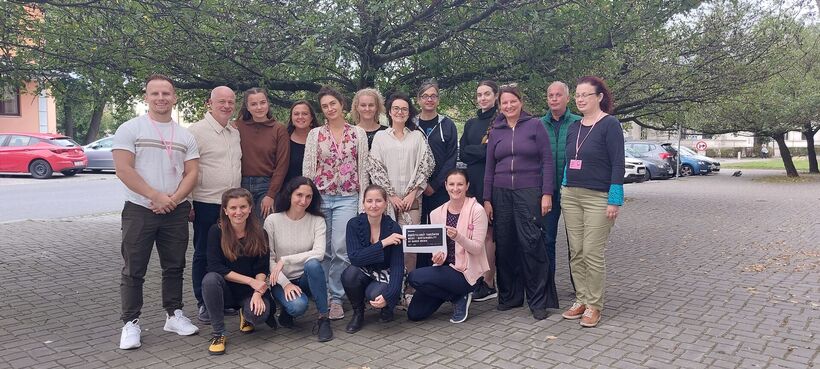Sustainability of dance media - Inspirational meeting with foreign editors
The long-term strategy of Czech Dance News is not only to develop reflection on the art of dance, but also to care for those who are engaged in this reflection. To provide new information, impulses and examples of good practice from abroad. Another such opportunity that opened up for dance journalists was the workshops entitled Sustainability of Dance Media. The three-day event took place in early October in Ostrava, during the tenth edition of the local MOVE Fest festival.
Three foreign personalities, each with many years of experience in the medium, were invited to lecture the workshops. From Germany came Nina Hümpel, publicist and founder of the Tanznetz.de internet platform, which has been covering the German dance scene for 26 years. Other guests were Jonathan Gray, editor-in-chief of the renowned British magazine Dancing Times, and Sanjoy Roy, dance critic of The Guardian and head of the Springback Magazine platform.
Thanks to the support of the European Union through the National Recovery Plan, twelve participants of the seminar were able to come to Ostrava and share their experiences with the lecturers and others. For two days, a diverse mix of journalists from the Czech Republic, Slovakia, Lithuania, Belgium and Bulgaria met in the morning and afternoon at the Hnízdo centre in Ostrava.
During the opening session, the workshop focused on introducing the media of each lecturer. Nina Hümpel presented her platform Tanznetz.de and its functioning. Since she founded it in 1996, at the time of the gradual flowering of the Internet, she was able to follow the overall development of this type of media over the years and at the same time to give others an insight into how it works within a large country like Germany. In her opening remarks, she already stated a fact that was not obvious to some of the seminar participants at the beginning - that the German government does not support the media financially in any way. Many entities in the Czech Republic and in the countries to the east of us are used to grant support. Czech dance journalists take it as a natural fact that they have the right to demand remuneration for their work. In contrast to this attitude, Nina Hümpel explained that her authors write about dance without any remuneration. Only the small team of editors who work on the submitted texts is remunerated in some way. However, the origin of this funding comes from a completely different source than state support, namely the profits from advertising cooperation. A platform like Tanznetz.de is therefore dependent on how active it is in the field of advertising and how it earns its keep. In order to cover the vast German dance scene, the editor-in-chief of Tanznetz.de collaborates with many authors from different regions. Thanks to the long years of operation, during which Tanznetz has become a respected medium, it is not a big problem for Nina Hümpel to find authors - they are interested in writing, the reason may be prestige or the community that Nina often mentions. The sense of belonging of authors writing about dance is very strong on this platform. Moderate support at the national level can be obtained if your activities touch a narrower profile, based on the regional scene. Thus, Tanznetz operates another entity focusing on dance in Bavaria. Such a narrowly profiled reflection helps the development of the region and is therefore entitled to some symbolic support. However, advertising-based funding still prevails.
The sector has been badly affected by the coronavirus crisis, which has caused a decline in advertiser interest. Jonathan Gray, editor-in-chief of the legendary Dancing Times magazine, which has been published continuously in Britain since 1910, mirrored a similar experience in his contribution. It was a monthly print magazine that later offered readers separate content on its website. The income from the sale of single issues of the magazine and subscriptions could not cover the costs, so due to a decline in advertising and a simultaneous increase in costs, the situation was such that Dancing Times could not continue and published its last issue in 2022.
Sanjoy Roy, in his opening remarks, briefed the meeting on the working principle of the Springback Academy, which had been set up as a companion programme to the Aerowaves Festival. Funded by the European Creative Europe programme, the Aerowaves Festival presents twenty emerging choreographers and their works each year, selected from a pan-European open call. And in the same way, Sanjoy Roy selects dance writers who descend on the festival site to watch the entire programme, which they report on while the festival is still in progress. They are coached by several professional dance critics and also gain experience from discussions with other writers.
This concept has gradually breathed life into the medium that keeps the Springback Academy artists active. Sanjoy Roy is currently the editor-in-chief of the online Springback magazine, which seeks to deepen the discourse on new dance creations. The focus is primarily on reflection, not on promoting individual choreographers or companies. He is primarily concerned with building a European community of artists. Here again we come to the community as already mentioned by Nina Hümpel. Her British colleague, however, is able to provide payment to authors thanks to Creative Europe.
In online media, one cannot help but notice the tendency to publish at least once a year a publication that would be published in print and would be a kind of artifact preserved in time. Both Tanznetz and Springback do this once a year, providing yet another dimension to the experience of reading about dance. In the same way, the Czech Dance News also includes among its projects a Special Edition, a printed publication with texts, which in the case of Dance News are , however, created directly for a given issue, so they are not published online.
The importance of working with young authors
Let's take a look at some of the themes that resonated during the workshops. Nina Hümpel's enthusiasm was very infectious, her genuine passion for dance journalists was very evident in her discourse. Naturally, as the head of a major media outlet, narrowly focused on the fringe genre that is dance, she is looking for ways to make her life easier. As of 2018, Germany has a critics' association, as well as an association of large dance companies, dancers, and educational institutions. Within these groups, its aim is to bring dance journalism more into the spotlight. It places great emphasis on working with archives, as it has an extensive history of reflection from Tanznetz, so one of the possibilities for sustainability is to nurture and make archival materials accessible. A lot of time is taken up by communication and negotiation regarding advertising published on the site. She would rather devote her energy to working with young writers who need practice and opportunity to write about dance, and to do so regularly.
Jonathan Gray countered that he would not want to be a young dance critic today, as his position is simply not enviable at all. Adepts writing about dance are more likely to find employment in other positions, such as dramaturg, rather than actually writing about dance for a living. Nina Hümpel has long been trying to come up with other promotional opportunities, such as a booth at the Tanzmesse dance fair or crowdfunding. When the question of paid content comes up, she doesn't see it as something that is achievable, as the public generally has a hard time paying for web articles that are about mainstream content, let alone culturally narrowly focused content. It prefers to send weekly newsletters to its readers, is active on jobmarkets and continues to develop its network of authors spread across all regions of Germany.
Tips for writing about dance
As Sanjoy Roy is an experienced editor and mentor, he also stopped during his talk to talk about nurturing authors. One of the features of sustainability for the dance medium is to continuously care for the writers and understand their situation so that they feel motivated to work with the medium in the long term and not stop writing. Sanjoy Roy offered dance journalists some insights on how to view their work, “Think about who you are writing for, where you are going with your writing, not the other way around. It's not so important where you are writing from, what your reason is for writing or what you are starting out with. Focus on the audience you're writing for.” One important aspect of writing about dance for Roy is to leave the door open for other people, not to get too technical, not to lecture. Keeping in mind that the reader is entitled to enjoy the reading and experience something pleasurable.
All of this is also related to the sustainability of dance media, and for the participants of the workshops, who are mostly also authors writing about dance, the lecturers provided a great deal of suggestions, advice and experience.
Several days in Ostrava offered a comparison of the functioning of another medium within the established practices and set rules in a foreign country, but also the personal experience and know-how of dance journalists, their personal enthusiasm and passion for their chosen medium.
Jonathan Gray, with his years of experience in the print medium, also stirred up a debate among the participants about the importance of print and our personal preference for printed materials. Their future is one of the big question marks and representatives from each medium are more likely to reflect on new approaches to content such as podcasts, video work and photoblogs.

Three days filled with workshops, MOVE Fest performances and a final debate on regional media concluded with the launch of the new publication of the Special Edition of Czech Dance News. The programme in Ostrava offered the participants many suggestions, concrete experiences and opinions that increased their insight into the functioning of media focused on the dance industry. Meeting people who are passionate about dance and want to publish about it, even though it brings more hardship than peace or satisfaction, was very inspiring and there is no choice but to continue and in a similar way maintain international links that support, inspire and inject blood into the veins and ink into the pens of dance journalists across Europe.
Written from the workshop Sustainability of Dance Media organised by Dance News in Ostrava, 6-8 October 2023, supported by the European Union and the Ministry of Culture through the National Recovery Plan.
Recording from the debate on regional media can be viewed here - https://youtu.be/66OyTkp2mLs



